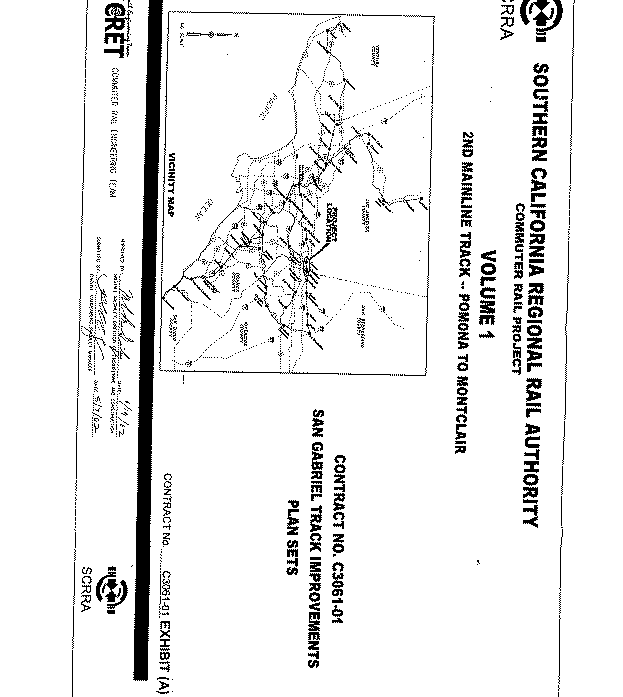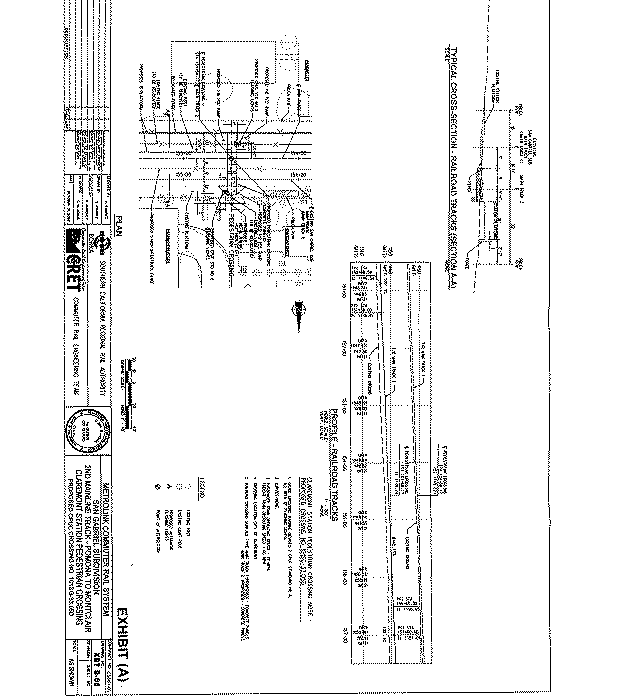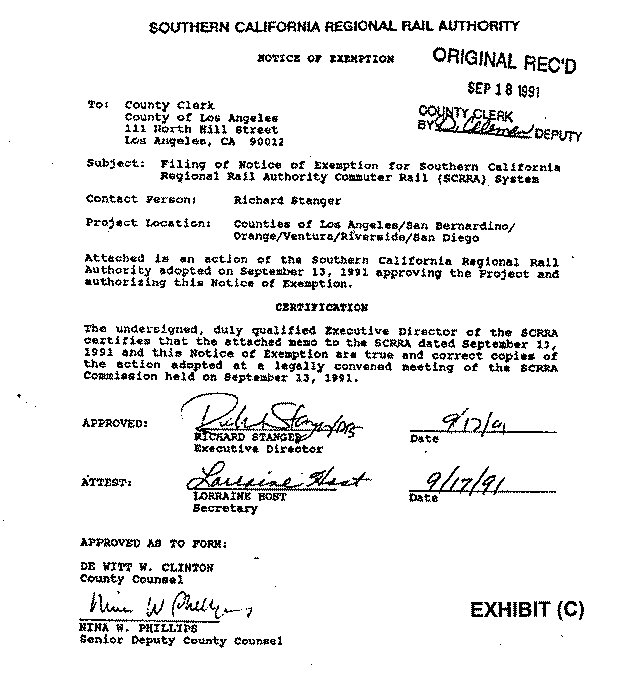Discussion
SCRRA is the five-county joint powers authority created pursuant to State of California Public Utilities Code Section 130255 and California Government Code Section 6500 et seq. to build and operate the Metrolink commuter train system. The five county member agencies are comprised of the following: Los Angeles County Metropolitan Transportation Authority (MTA), Ventura County Transportation Commission, Orange County Transportation Authority, San Bernardino Associated Governments and Riverside County Transportation Commission. SCRRA builds, operates and maintains the commuter rail system in the five county areas on rail rights of ways owned by the member agencies. MTA is the owner of the right of way for this project.
SCRRA currently has a single main line track in this area. The crossing will have two tracks when SCRAA builds a second main line track and a new second platform at the Claremont station. A site map of the grade crossing is as shown on plans attached to the application and Appendix A.
The 8-foot wide crossing surface will be made of concrete panels. The crossing warning devices will consist of CPUC Standard No. 8 (highway crossing flashing light signal assembly as described in General Order (GO) 75-C) located on each side of the railroad track. Signal house, train detection and signal control circuitry, track circuits and other equipment necessary to make the two crossing signals function as a system will also be installed at the crossing. SCRRA will also replace the existing railroad track (rail, ties, ballast and other track materials) with a new railroad track and pre-cast concrete panels. The general plan with layout for at-grade pedestrian-rail crossing is shown in Appendix B.
SCRRA will maintain, repair and renew the crossing area between lines two feet outside of the rails of the track. When two or more tracks are involved, SCRRA shall maintain the area between the tracks. The maintenance shall be done pursuant to GO 72-B.
Due to the concerns of the Commission's Consumer Protection and Safety Division - Rail Crossings Engineering Section (RCES) on the safety and public need for the proposed crossing on June 6, 2003 SCRRA filed a supplement to the application. In the supplement, SCRRA explained that the crossing is needed to provide improved access and convenience to disabled persons who drive to the station to ride Metrolink. There are handicapped parking spaces near the existing depot building. Disabled people using these parking spaces would have to travel east on the existing north platform to reach the end of the platform at College Avenue at-grade highway-rail crossing (CPUC Crossing No. 101SG-33.1), cross College Avenue at-grade highway-rail crossing, and then travel west on the south platform all the way to the end of the platform to reach the handicapped ramp. In addition, the proposed at-grade pedestrian-rail crossing will provide convenience to commuters who purchase tickets on the north platform and board trains on the south platform.
As described in the supplement, additional safety measures at the proposed at-grade crossing include tactile strip1 and platform markings. Yellow tiles will be located at the edge of the platform to mark the end of the platform. Platform markings will consist of a two-inch wide yellow line and warnings that read "Warning Stay Back of the Yellow Line " on each platform. These will provide warning to commuters on the platforms to advise them where to stand and where to cross from one platform to the next in a safe manner.
The Los Angeles to Pasadena Metro Construction Authority (Authority) and San Gabriel Valley Council of Governments (COG) have decided to pursue a Phase II extension of the Gold Line east to Claremont from Pasadena. The COG and Authority have agreed to work as a team on Phase II, seeking federal government assistance in financing the project. The City of Claremont has agreed to replace this proposed at-grade pedestrian-rail crossing with a new grade-separated pedestrian-rail crossing when the Gold Line Extension is completed through this Metrolink station.
SCRRA is the lead agency for this project under the California Environmental Quality Act of 1970 (CEQA), as amended, Public Resources Code Section 21000 et seq. SCRRA determined that this new commuter rail system project, a project that institutes passenger commuter rail services on rail rights of way already in use is statutorily exempt from CEQA under Section 21080 (b) (11) of California Public Resources Code and CEQA Guidelines Section 15275. Section 21080(b) (11) provides an exemption for projects to increase passenger commuter services on rail or highway rights of way already in use, including modernization of existing stations and parking facilities. Section 15275 provides a corresponding categorical exemption under the CEQA Guidelines. SCRRA filed Notice of Exemption from CEQA for construction and operation of a commuter rail system on September 18, 1991. A copy of this Notice of Exemption is attached in Appendix C.
The Commission is a responsible agency for this project under CEQA. CEQA requires that the Commission consider the environmental consequences of a project that is subject to its discretionary approval. The specific activities that must be conducted by a responsible agency are contained in CEQA Guideline Section 15096.
The Commission has reviewed SCRRA's Notice of Exemption under CEQA Guideline 15275. The Notice of Exemption is good for an undefined period of time because the activities covered by this exemption are so broad and some of the contemplated activities might not take place until some years after the original project was built. We adopt SCRRA's determination that the project is exempt from CEQA for purposes of our approval.
RCES staff has inspected the site of the project. RCES examined the need for and the safety of the proposed crossing and related railroad construction and recommends that the application be approved.
The application is in compliance with the Commission's filing requirements, including Rule 38 of the Rules of Practice and Procedure, which relates to the construction of a public road, highway, or street across a railroad.
In Resolution ALJ 176-3103, dated December 18, 2002, the Commission preliminarily categorized this application as ratesetting, and preliminarily determined that hearings were not necessary. Since no protests were filed, this preliminary determination remains accurate. Given these developments, it is not necessary to disturb the preliminary determinations made in Resolution ALJ 176 -3103.
This is an uncontested matter in which the decision grants the relief requested. Accordingly, pursuant to Public Utilities Code Section 311(g)(2), the otherwise applicable 30-day period for public review and comment is being waived.
Assignment of Proceeding
Richard Clark is the assigned Examiner in this proceeding
1. Notice of the application was published in the Commission Daily Calendar on December 11, 2002. No protests were received. A public hearing is not necessary.
2. SCRRA requests authority, under Public Utilities Code Sections 1201-1205, to construct a permanent at-grade pedestrian-rail crossing at the Claremont Metrolink Station in the County of Los Angeles.
3. The City of Claremont has agreed to replace the at-grade pedestrian-rail crossing with a new grade-separated pedestrian-rail crossing when the Gold Line extension is completed through this Metrolink station.
4. Public convenience, necessity and safety require the construction of Claremont Metrolink Station at-grade pedestrian-rail crossing.
5. SCRRA is the lead agency for this project under CEQA, as amended.
6. This new commuter rail system project, a project that institutes passenger commuter rail services on rail rights of way already in use, is statutorily exempt from the CEQA under Section 21080 (b) (11) of California Public Resources Code and CEQA Guidelines Section 15275.
7. SCRRA filed Notice of Exemption from CEQA for construction and operation of a commuter rail system on September 18, 1991.
8. The Commission is a responsible agency for this project and has reviewed and considered the lead agency's Notice of Exemption.
1. This order should be effective immediately as SCRRA wishes to commence construction of the project at the earliest possible date.
2. We find that the environmental documents are adequate for our decision-making purposes. We adopt SCRRA's finding that the project is exempt from CEQA for purposes of our approval.
3. The application should be granted as set forth in the following order.
IT IS ORDERED that:
1. Southern California Rail Authority (SCRRA) is authorized to construct the at-grade pedestrian-rail crossing at the Claremont Metrolink Station on the SCRRA's Valley Subdivision track at milepost 33.05 in the City of Claremont, County of Los Angeles.
2. The crossing warning devices shall consist of CPUC Standard No. 8 (highway crossing flashing light signal assembly as described in General Order (GO) 75-C) located on each side of the railroad track.
3. A tactile strip shall be located at the edge of the platform to mark the end of the platform. Additional platform markings shall consist of a two inch yellow line and warnings that read "Warning Stay Back of the Yellow Line" on each platform.
4. The City of Claremont shall replace the at-grade pedestrian-rail crossing with a new grade-separated pedestrian-rail crossing when the Gold Line extension is complete through this Metrolink Station.
5. Clearances shall be in accordance with GO 26-D.
6. Walkways shall conform to GO 118. Walkways adjacent to any trackage subject to rail operations shall be maintained free of obstructions and shall be promptly restored to their original condition in the event of damage during construction.
7. Construction and maintenance costs shall be borne in accordance with an agreement to be entered into between SCRRA and City of Claremont (parties). A copy of the agreement, together with plans of the project, shall be filed with the Commission by SCRRA prior to construction. Should the parties fail to agree, the Commission will apportion the costs of construction and maintenance by further order.
8. Within 30 days after completion of the work under this order, SCRRA shall notify the Rail Crossings Engineering Section in writing, by submitting a completed standard Commission Form G (Report of Changes at Highway Grade Crossings and Separations), that the authorized work was completed.
9. This authorization shall expire if not exercised within one year unless time is extended or if the above conditions are not complied with. Authorization may be revoked or modified if public convenience, necessity, or safety so require.
10. The application is granted as set forth above.
11. Application 02-12-009 is closed.
This order is effective today.
Dated , at San Francisco, California.





